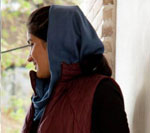 Bloomberg: “Easily 90 percent of them have gone overseas,” the 29-year-old software developer said, reflecting on a middle-class flight that has seen many of the nation’s best scientists and engineers leave. “Of my 45 university classmates, I guess maybe five are left.”
Bloomberg: “Easily 90 percent of them have gone overseas,” the 29-year-old software developer said, reflecting on a middle-class flight that has seen many of the nation’s best scientists and engineers leave. “Of my 45 university classmates, I guess maybe five are left.”
By Golnar Motevalli

Drawing on a cigarette at his flat in central Tehran, Araz Alipour counts on one hand his college friends who have chosen to build a career in Iran.
“Easily 90 percent of them have gone overseas,” the 29-year-old software developer said, reflecting on a middle-class flight that has seen many of the nation’s best scientists and engineers leave. “Of my 45 university classmates, I guess maybe five are left.”
Photographs of new cars, homes and expanding families posted on Facebook and Instagram document some of the tens of thousands of Iranian lives transplanted each year, mainly to Europe and North America. Seyyed Hassan Hosseini, deputy chief of Iran’s National Elites Foundation, said on April 20 that over the past two years at least 40 percent of top-performing students in science and engineering left the Persian Gulf nation.
The flood of emigrants has rung alarm bells at the highest level. President Hassan Rouhani prioritized stemming the tide of “fleeing brains” during his election campaign last year. As global companies plot a post-sanctions strategy for Iran amid optimism that nuclear talks may ease its isolation, they could find their ambitions thwarted by a skills shortage.
Each day, Tehran’s vast Enghelab Square becomes home to clusters of booksellers, translators and document-verifiers, a cottage industry catering to students dreaming of a life abroad.
“Mostly they want to go to Canada, Australia, Germany or Sweden,” said Bahram Yousefi, a baby-faced 26-year-old who renders applications written in Farsi into English and other European languages. “There’s no job security, no life security here,” Yousefi said, adding that he aimed to go too once his military service was over.
Not Returning
More than 5,600 Iranians arrive annually to study in the U.S. alone, according to a 2011 report by the Institute for International Education cited by the State Department. The number rises by a fifth each year.
Many won’t return. A 2012 survey by the Washington D.C.- based National Science Foundation said 89 percent of Iranian doctoral students remained in the U.S. after graduation, the joint highest percentage of all nationalities surveyed, alongside Chinese. Iran’s Shargh newspaper found that 140 of 255 students who participated in International Science Olympiads between 1993 and 2007 were at leading universities abroad.
While Iranians had been leaving since before the 1979 Islamic revolution, the economic decline and disputed election presided over by Rouhani’s predecessor, Mahmoud Ahmadinejad, spurred a new wave of migration. A rising tide of angry rhetoric aimed at the U.S. and Israel, and strident defiance of calls for monitoring of Iran’s nuclear program, led to tighter sanctions and deeper isolation.
Sanctions Relief
The repair job has begun. Iran won as much as $7 billion in relief from sanctions under a November interim nuclear accord and hopes to sign a permanent deal by July. Inflation slowed to a two-year low of 23 percent in February and the International Monetary Fund forecast the economy will expand for the first time in three years in 2014, growing 1.5 percent.
Math graduate Mehrdad Agha-Bozorgi, 31, chose to stay. Yet almost all of the 300 students from his Tehran high school days settled abroad. “They are either at really good universities or have really good jobs,” he said.
One is Mohammad, a postdoctoral student of communications at an institute in Ireland, who asked that his surname and the name of the college not be published. His sister is at the Massachusetts Institute of Technology, while a brother is a postgraduate at Canada’s McGill University.
$500 a Month
“No matter how good you are, you’re never going to earn $3,000 a month in Iran, and that’s a starting salary for Iranians in Canada or the U.S.,” Mohammad said by phone.
While there’s no official data, graduates who recently began work in Iran said they earn at most $500 a month.
From his corner office on the large garden campus of the Institute for Research in Fundamental Sciences in northern Tehran, Reza Mansouri said it’s not just poor pay that fuels the migration.
Mansouri, a former deputy science minister who also teaches physics at Tehran’s elite Sharif University of Technology, bemoans the lack of investment in science and an emphasis on religious ideology in higher education that he blames for fueling the exit of Iran’s brightest minds.
“Students want to be able to grow and blossom intellectually, this society doesn’t allow that to happen,” said Mansouri, a short distance from the single-story buildings where some of Iran’s top astronomers and physicists carry out their research with the snow-capped Alborz mountains looming in the distance.
Little Investment
Under the current five-year economic plan which began in 2010, about 2.5 percent of GDP was allotted for science and technology research. According to Mansouri, figures released last year estimated actual investment far below that figure.
After graduating in Vienna in the early 1970s, Mansouri returned after the revolution to help build a new Iran where the professional class could see a future. It hasn’t happened. He spends at least an hour a day writing recommendation letters for students applying to overseas universities.
“Each year, we admit about 50 physics students,” Mansouri said. “I’ve counted the ones who stay, and it’s around two.”


